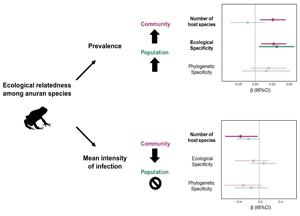Published online by Cambridge University Press: 26 January 2022

Understanding the determinants of parasite infection in different hosts is one of the main goals of disease ecology. Evaluating the relationship between parasite–host specificity and infection parameters within host communities and populations may contribute to this understanding. Here we propose two measures of specificity that encompasses phylogenetic and ecological relatedness among hosts and investigated how such metrics explain parasite infection prevalence and mean infection intensity (MII). We analysed the parasites associated with an anuran community in an area of Atlantic Forest and used the number of infected hosts and the net relatedness index to calculate the phylogenetic and ecological specificities of the parasites. These specificity measures were related to infection metrics (prevalence and MII) with generalized linear mixed models at community (all hosts) and population (infected host species) scales. Parasite prevalence was correlated with the number of infected hosts and, when considering only multi-host parasites, was positively related to parasite ecological specificity at community and population scales. Thus, parasite species have similar prevalences in ecologically closer hosts. No relationship was found for parasite MII. Incorporating ecological characteristics of hosts in parasite specificity analyses improves the detection of patterns of specificity across scales.